Editorial
The start of June down here was like winter of old; skies the deepest of deep, clear blue; not a cloud anywhere, 21°C during the day, and cold as charity at night. Brisbane even experienced the coldest day in 44 years, reaching 5° (41F) at the Airport (which is sea level, or below in places). A balmy day in other parts of the world, I imagine, but enough to make we locals think that the end of the world is neigh. This led to warm nights by the fireplace, causing Ruthie to look at the area and think, renovation time.
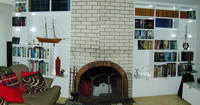
Having learnt when loosing is inevitable, I agreed and the result is good! New bookshelves and cabinets went in either side of the fireplace, blocking off two western wall windows, and allowing me to move a stack of non-technical books out of The Library, freeing valuable shelf space which can now be filled with reference material (magazines) currently in rather inaccessible storage. The downside—there's always one—is that in moving biographies and fiction from A to B, my list of "must re-read that" reached epic proportions. Two high on the list are the Chuck Yeager and Bob Hoover autobiographies. So much to do and I swear, if work at the University was not so much fun, I'd give it away today!
On the subject of reading, both Ruthie and I have Amazon Kindles to which we are addicted, especially for bed time and airplane reading (you don't loose your place when you fall asleep and drop the "book"). Sadly, Amazon spat the dummy about 18 months back over a dispute with publisher McMillian. Amazon claimed that as a retailer, they would set the price for eBooks and if this was below cost, that was their worry, not the wholesaler's. McMillian had just concluded a deal with Apple's iTunes store that saw their eBooks selling at equal or greater than the paperback price (paperbacks in Australia are two to three times the US cover price, so it's still a good deal). Amazon, who wanted to maintain a sub US$10 price for eBooks disagreed and after negotiations failed, they pulled all McMillian eBook titles from their Kindle store.
This greatly decreased Amazon's available range of eBook titles, so perhaps it was no coincidence that not long after, they opened their eBook format to self-publish authors and let me warn you, there are some absolutely pitiful attempts being sold that no editor worthy of the name would pass. This I know from trying a couple of $2.99 efforts having run out of new titles from "real" authors in my genre (SF and Fantasy).
The McMillian eBooks are available, but only through Barnes & Nobel and the Apple iTunes Store, neither of whom sell them to customers outside the US. To ensure this, their on-line stores pull some neat tricks with credit card numbers and geolocation of on-line shoppers. To me as a researcher into web site techniques, this was a red rag and with a bit of effort, effective countermeasures were identified for both. Maybe I got carried away at this point, as not wanting to read from a computer or laptop in bed, I had to purchase an Apple iPad to run the Apple iBook reader and the B&N "Nook" reader (and the iPad version of the Kindle for completeness).
So I'm cool now for content, but it has made me really think hard about the direction and future of publishing. Amazon boasts that their eBook sales have overtaken the sales of the related hardback and paperback versions (guess Amazon customers just don't buy McMillian titles from Amazon). I can't see the print book/magazine ever dying, but the shear convenience of instant delivery and not having a physical artefact to store after it's been read are winners for me. The Internet has made us a global society and on-line shoppers get quite miffed when they try to add an item to their cart only to be told it is not available in their region. Some sites detect the shopper's location using their TCP/IP address and hide items not available to them. This may avoid some angst, but people have a habit of finding out what is available and get angry when it is obviously being denied to them.
The deals between publishers and their regional distributors are outdated, some going back to the 19th century. I suspect that publishers and retailers are going to have to re-think distribution as no matter what they try to do to maintain their monopolistic control, there will be hackers who delight is breaking their restrictions, then telling the world about it via the Internet. At least one of the cunning side-step services appears legal to me (see US Unlocked). Others are less so, but the number of them indicates that on-line shoppers are just not to be denied. The end looks inevitable to me, though there may be pain before gain.
Go Go Road Roller
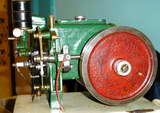
In the April 2011 MEN, we mentioned that the Engineers' Emporium would be offering castings for the venerable Westbury designed Averling Road Roller, notable for its water hopper cooled IC engine and infinitely variable, reversible transmission. The Emporium web site still has no mention of it, but their advertisement in the latest issue of Model Engineers' Workshop mentions it and even uses the photo from Page 10 of our Gallery. Still no indication of cost, and whether the IC engine parts will be available separately from the chassis parts, or even if the chassis parts will be available at all. More when I know more!
A New Auto V8
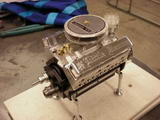
If you like water cooled V8's, here's a new design by Steve Huck which may well be just what you have been looking for. Steve is no stranger to these pages having kindly made his article on Cam Making available to us. His plan set for Little Demon V8 comprises 68 pages of very clear, but detailed 3D CAD work. This is a totally complete plan set with full details of the engine components including construction of the radiator, display mount, and very nice little 8-40 thread spark plugs! The latter use Corian as the insulator and Steve shows a cunning little tool for swaging the plug body over the insulator to form a good pressure seal.

The plans represent about five years of work and Steve makes no secret of the fact that the prototype, while nearing completion, has yet to be fully proven. Some my see the plan release as premature, but pressure from the builders anxious to make a start has passed boiling point, hence the move to at least let folk make a start on the proven parts. The V1.0 plans are available by dropping an email to Steve. The total cost is US$50.00 via PayPal with electronic delivery (pdf). Registered owners will receive plan updates and revisions, and Steve plans to detail a blower as an add-on option after the base engine is finalized.
Another Boll-Aero
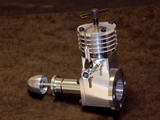
Our Boll-Aero Gallery Page receives another entry this month with the example made by Shane Alce (UK). Shane found the MEN website by accident a couple of years ago while searching for the Boll Aero drawings and have been an avid browser ever since. The engine reawakened his interest in model engineering and led to a re-acquaintance between Shane and his Myford ML7 which had languished in the workshop unused since his last house move. Construction started over the Christmas holidays and finished late June 2011. As well as looking good, the engine runs as advertised and Shane is now starting the progenitor of the Boll-Aero: the 0.8cc ML Midge. Although smaller, the Midge will be more of a challenge as the fits become more critical as size decreases, but based on the quality evident in the small details of his work, Shane should have no trouble. Click the image to see more photos and details of this entry in the growing Boll-Aero Gallery.
The Complete Gnome
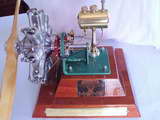
Last time Les Stone and I were talking about his Chenery Gnome rotary project, lots of little things that would take a lot of time to complete remained to be done, such as the cam rings (one per cylinder), roller tappets, etc. Well Les must have burned a years' supply of midnight oil in the past month because here is his 100% complete engine, beautifully presented and ready to a run, once Les "motors" it on the lathe to relieve the inevitable tightness one is to expect on a complex multi-cylinder rotary engine that has just been assembled for the first time.
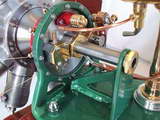
The tank has separate sections for oil and fuel. The oil supply has a metering needle and the fuel an on-off tap at the bottom. Air induction is through the long tube which also serves as the engine mount. If you are unsure about rotaries, everything aft of the big green mounting ring is stationary, while everything forward of it spins! The red ring is the insulated ignition commutator and the bare copper wire lengths leading to the sparking plugs are authentic, just like the Gnome examples in the San Diego Air and Space Museum. Les provided more photos showing detail close-ups of the engine which I'll keep until the engine can be given pride of place on the Les Stone Tribute page of the Engine Gallery.
Minimag Again
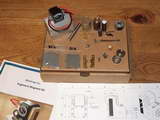
Back in the January 2011 issue, we noted that the Jim Shelley designed Minimag magneto kits were on the verge of being available again. The gestation has been long as the new owner, Julian Kent, traversed the long learning curve of coil winding and impregnation, found replacement suppliers for critical components, revised the documentation and packaging, and a host of other tiny hurdles. Well kits are now available from Minimag Co in the UK for £88.00, plus postage. The magneto has been renamed the Falcon, after Jim Shelley's flat-four, reviewed here way back in the August 2005 issue. John Moore has built an example from a pre-production kit and posted a running commentary of the process on the MadModder Simple Machines Forum. In a marketing ploy I totally endorse, Julian has made the kit documentation available for download so you can see precisely what goes into making a working, miniature magneto.
Minimag Co also offers the heavy duty Novus spark ignition coil suitable for 4 to 6 volt operation, in both single and double configuration. Where space and weight are critical, try the smaller Spark Demon (the same coil as supplied in the Falcon kit) for 2 to 6 volt systems. The web site accepts PayPal, but non-UK residents should email first to establish shipping costs to their part of the world.
Twins Twice Over
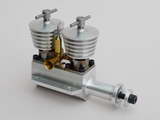
Knowing Ron is a sucker for twins, Jan Huning (UK), has sent in photographs of a pair of darling little in-line diesel twins he has made. The smaller totals about 1cc for both pots having a bore of 5/16" and a stroke of 3/8", with sideport induction. This one will turn an 8" wooden prop and just under 10K RPM. Adjustment is sensitive, especially if one cylinder "drops out" causing the other to go over-compressed, but with a little finesse, both can be adjusted for solid running.
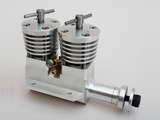
The other is a tad larger at 1.5cc total, having a 3/8" bore with 0.414" stroke. Induction is via rotary valve using the center "spool" with opposed, angled ports to supply what are effectively two separate but coupled engines. Like her smaller cousin, the assembly problem is solved using a split aluminum bearing, sealed with O Rings, just like Ken Croft and I did for our Millennium Sparey Twins back in 2000. The cylinder porting of the 1.5cc twin uses Oliver style angled transfers, a feature requiring quite precise setup and machining at this size. Jan notes that it can be started on one cylinder with the compression of the other backed off. The increase in noise and excitement as the second is brought into action is quite dramatic—something I can confirm from the Taplin Twin Prototype Replica experience.
Now if you are anything like me, you'll be itching to see what's inside the little twins. Luckily, Jan foresaw this burning need and provided well posed photographs of the engine components which should satisfy the curious. I've said many times that making really small IC engines is one of the most challenging exercises in precision a Model Engineer can undertake. To double up the trouble with a twin and achieve success twice (as those who saw Jan running the twins at Old Warden recently can attest) marks this as a really worthy effort.
Tug's Big Eaters
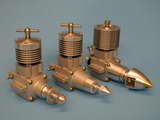
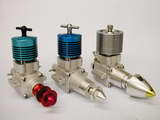
Sounds like a pack of hungry dogs, and the comparison may be close to the mark as these ETA diesel replicas are double the capacity of their prototype counterparts and would guzzle that expensive ether brew at a rate like, well, a pack of hungry dogs! The engines, made entirely from the solid using nothing more than milling and hand finishing, are the exquisite work of Ramon "Tug" Wilson (UK). We've seen Tug's work before in the form a double capacity ED Racer. For the ETA 15's, Tug selected three different evolutions of the engine, including the rather rare drum valve version (far right in the photos). This model employed the plastic venturi mount from a Cox TeeDee 049 to thermally isolate the spray bar from the engine in an effort to reduce fuel vaporization and so increase Team Race endurance. Tug has replicated this, machining his own housing from a very tough black plastic material, achieving—somehow—a finish every bit as smooth and shiny as injection molding. I rather like the anodizing job, although the original ETA engine used a very "washed out" pale color in their own versions—sort of in-keeping with the quintessential British Understatement. Tug's brilliant colors look far more aggressive, somehow.
New Books and Magazines This Month
New entries into The Library during June included my eagerly awaited annual fix of the Engine Collectors' Journal. ECJ is available as a six issue subscription—nominally one year, depending on material availability—or if like me, you can postpone instant gratification, a bound volume of six issues. The latest is Volume 35, comprising issues 199 through 204. Yup, that's right. ECJ has quietly turned 200! That's a major milestone in anybody's books and Editor Tim Dannels is to be congratulated for his sterling effort in launching and sustaining ECJ for the past xx years. Well done Tim!

As mentioned when I reviewed ECJ Volume 34, ECJ now sports a glossy, full color cover that really makes the featured engine stand out. Here we see the cover for issue #199 and yes, it's a Chunn Chum, which was our Members' free plan from the March 2010 MEN issue. ECJ #199 delves into the various manifestations of the Chum, drawing some quite reasonable hind-sight conclusions about all the variations of the engine. In Issue @200, Jim Dunkin and Craig Asher give chapter and verso on the Dooling-like Howler in all its various sizes and revisions, while in Issue #210, the semi-regular Meet the Collector feature introduces George Genervo, who readers may recall from last month as designer and supplier of the Titan 60 kit engine. A three-part series on the Fox .59 commences in issue #202, starting with the highly collectable 1947 "long shaft" 59.
Each of the six issues in Volume 35 runs to 14 pages including the cover and our summary has barely scratched the surface of what those 84 pages contain. Add this to the other 198 issues and we have a mountain of interesting stories and reference data, provided you have a good memory. For the rest of us, there Bill Bickle's ECJ Index. I've never actually see this item, but Tim says it's excellent and he should know. Domestic USA readers may order their copy from the ECJ Website for US$17.50. Back volumes are available all the way back for progressively less. Overseas customers can get three volumes delivered by priority air for just US$14.00. While I'm not precisely non-partisan where ECJ is concerned, believe me when I say this is a Five Star publication  .
.
Engine Of The Month: K 2cc Trio
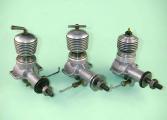
This month, Adrian Duncan completes his coverage of the "K" range of British engines with the K Model Engineering Company 2cc models, namely the K Falcon, Kestrel, and Tornado. The first two are diesel, the latter, glow, although Adrian mounts a strong case in support of his belief that the 1.96cc Tornado was a rather crude conversion of the Kestrel. His tests certainly highlight the performance gap between the two, even running the Tornado on 10% nitromethane which as Adrian points out, would have been close to unobtanium in the UK of 1950! This piece completes the in-depth coverage of the legacy of Harold Kemp, for which Adrian and his many supporters and collaborators are to be sincerely thanked.
Tech Tip of the Month

I just knew while preparing last month's thoughts on the minimum workshop needs making model IC engines that I'd forget something, and that the something would probably be important. Well I was right and wrong. I did forget a few somethings, and although the importance is less than critical, the items are things which the would-be Model Engineer should keep in mind, so the page has been updated. To save you the daunting task of finding just what has been added, the links below take you direct to the three new sections dealing with the top, or compound side, an aid to thread-cutting, and the humble bench vice.
By the way, along with the taper turning attachment, you don't need a hand-turning rest, nor a dividing head either, although the latter makes a great home-shop project after you gain a bit of experience in lathe accessory making  .
.
Briefly Noted
This section is intended to alert you to little things that are hard to expand to a full news item, or cunningly wind into the Editorial, but are worthy of note never the less.
- YES! Model Engine News now has 1001 different pages of reviews, how-to articles, and other esoteric useless information available free to all (plus a few pages you need to be a paid up Member in Good Standing to access; Join Now!
 ).
).
- Uncle Tim emailed to congratulate MEN on the discovery of a brand new McCoy. Tim is right and the error is all my own: there never was a McCoy 061 diesel and readers who clicked through my mistake in the June Engine of the Month to Adrian's McCoy Diesels review will know that the engine in question was an 099, not an 061 (I knew that). Sorry to Tim, Adrian, and Dick (who may now stop spinning in his grave); error now corrected and it's just as well my sense of taste can no longer tell the difference between crow from beef (they both taste like crow).
- Charlie Stone managed to re-assemble his Metamorph 60 and sent a photo of it on one piece. This has been added to the page and to answer the question which perplexed at least one reader, an explanation of how the engine goes together has been added.
- The McCoy Diesels page got let out of the Engine Finder somehow. Fixed now.
- From Model Engineers' Workshop #178, I see that TEE Publishing, who maintains a Capital-L for Large selection of Model Engineer back issues has a Special Offer currently running on multi-volume sets (unbound). You can get four volumes from 1943-60 for £39.50, three from 70-81 for £32.50, and two from '93-2004 for £30.00 (postage extra). The offer closes on October 31 and you need to quote special offer codes MEW05, MEW06, or MEW07 respectively when ordering. There is another offer (MEW08) that will give you two free volumes #98-119 inc (being 1945-58) if you order any six volumes at the normal price.
- The Tap & Die Company has been added to the Suppliers List. They are UK based but ship anywhere and stock US, Metric, and UK thread makers, including the 32 and 40 TPI Model Engineer series, obsolescent (BA) and obsolete (British Cycle etc) types. Boxed sets of many types are available as are left-handed taps and dies, involute and other types of cutters, drills, reamers, and many other related goodies.
 Go Go Road Roller
Go Go Road Roller
 A New Auto V8
A New Auto V8
 Another Boll-Aero
Another Boll-Aero
 The Complete Gnome
The Complete Gnome
 Minimag Again
Minimag Again
 Twins Twice Over
Twins Twice Over
 Tug's Big Eaters
Tug's Big Eaters
 Editorial
Editorial
 New Books and Magazines This Month
New Books and Magazines This Month
 Engine Of The Month: K 2cc Trio
Engine Of The Month: K 2cc Trio
 Tech Tip of the Month
Tech Tip of the Month
 Briefly Noted
Briefly Noted
 Standard Stuff
Standard Stuff











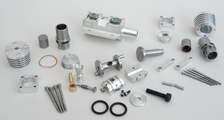
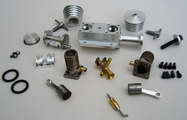



 .
.


 .
.